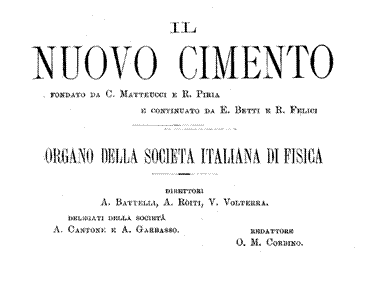The Uncredited Discoverer of Cosmic Rays
The history of science is littered with injustices and today Alessandro De Angelis at the University of Udine in Italy outlines another associated with the discovery of cosmic rays .

Today, the person largely credited with the discovery of cosmic rays is the Austrian physicist Victor Hess. In the early part of the 20th century, the large amount of ionising radiation in the Earth’s atmosphere caused a great deal of head-scratching.
The world’s physicists naturally assumed that the origin of this radiation was the Earth’s crust but were puzzled by measurements that seemed to show that radiation levels increased higher up in the atmosphere.
Hess developed a technique for measuring radiation levels with much greater accuracy and then flew himself and his apparatus by balloon to altitudes of over 5 kilometres to take measurements. The data revealed that radiation levels at 5km were about twice as high as at sea level.
Hess rightly concluded that the Earth could not be the source of this radiation, which was later christened cosmic rays.
But Hess wasn’t the only one working on this problem. De Angelis points out that the Italian scientist Domenico Pacini at the Italian Agency of Meteorology and Geodynamics made the same discovery at the same time with a slightly different method. Instead of flying his measuring apparatus at altitude, Pacini placed it in a copper box and submerged it in the salty waters of the Bay of Livorno.
He found that the intensity of radiation underwater was significantly less than at the surface and concluded, like Hess, that it could not be coming from the Earth. De Angelis has even unearthed the paper in which Pacini published this work and offers the first English translation on the arXiv.
De Angelis points out that both men were aware of each other’s work but that their scientific legacies are very different. “While Hess is remembered as the discoverer of cosmic rays, the simultaneous discovery by Pacini is forgotten by most,” he says.
Google confirms this assertion with blunt ignominy. While typing the phrase “Victor Hess” into the search engine gives you over 900,000 results, doing the same for “Domenico Pacini” gives only 90,000, the first of which is the question “Did you mean: Domenico Pacitti”.
It’s not hard to understand why. Pacini died in 1934. Two years later, the Nobel Prize for Physics (which cannot be awarded posthumously) was given to Hess for his work on the discovery of cosmic rays.
Ref: arxiv.org/abs/1002.1810: Penetrating Radiation At The Surface Of Water
Keep Reading
Most Popular
Large language models can do jaw-dropping things. But nobody knows exactly why.
And that's a problem. Figuring it out is one of the biggest scientific puzzles of our time and a crucial step towards controlling more powerful future models.
How scientists traced a mysterious covid case back to six toilets
When wastewater surveillance turns into a hunt for a single infected individual, the ethics get tricky.
The problem with plug-in hybrids? Their drivers.
Plug-in hybrids are often sold as a transition to EVs, but new data from Europe shows we’re still underestimating the emissions they produce.
Google DeepMind’s new generative model makes Super Mario–like games from scratch
Genie learns how to control games by watching hours and hours of video. It could help train next-gen robots too.
Stay connected
Get the latest updates from
MIT Technology Review
Discover special offers, top stories, upcoming events, and more.